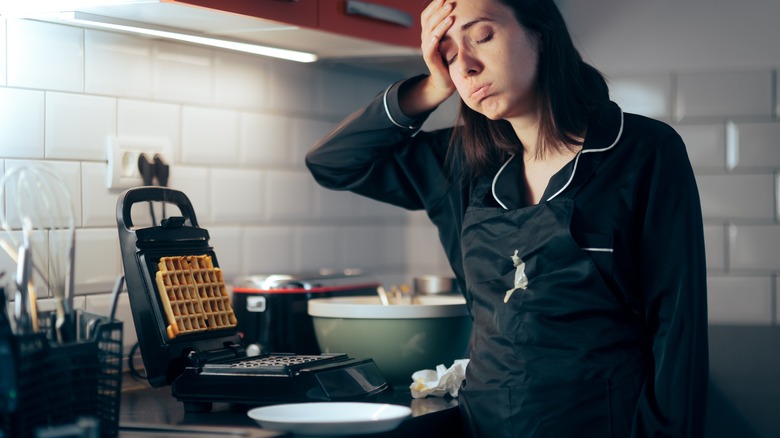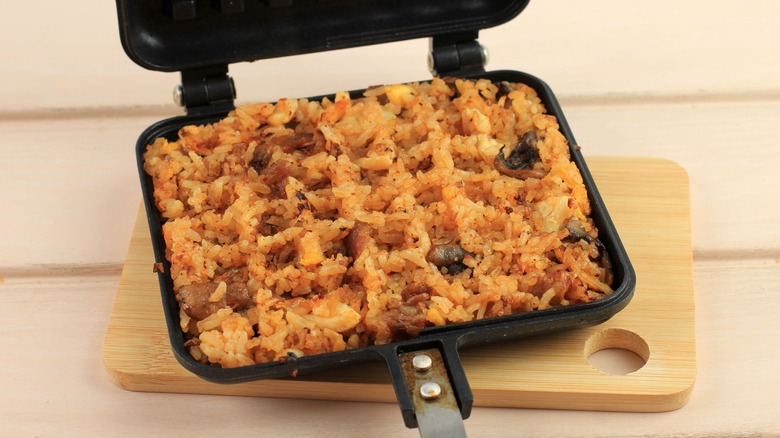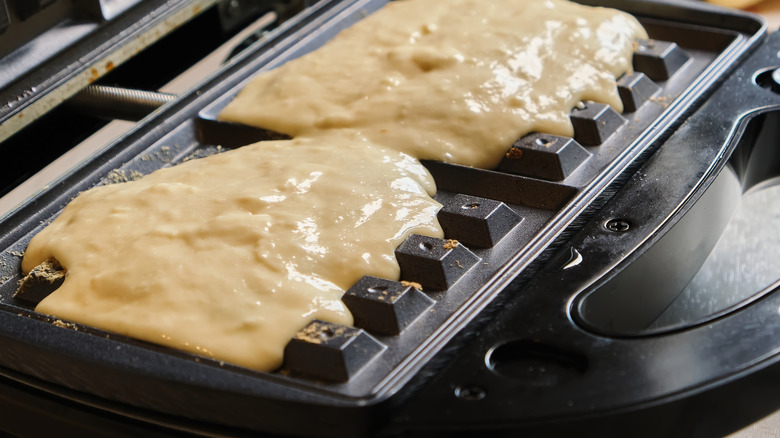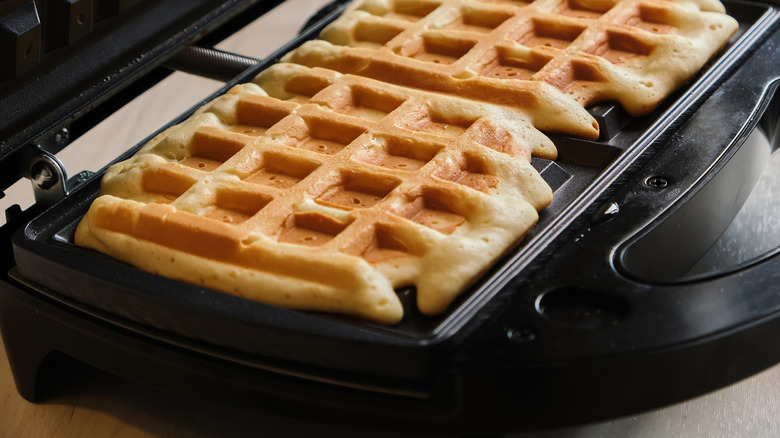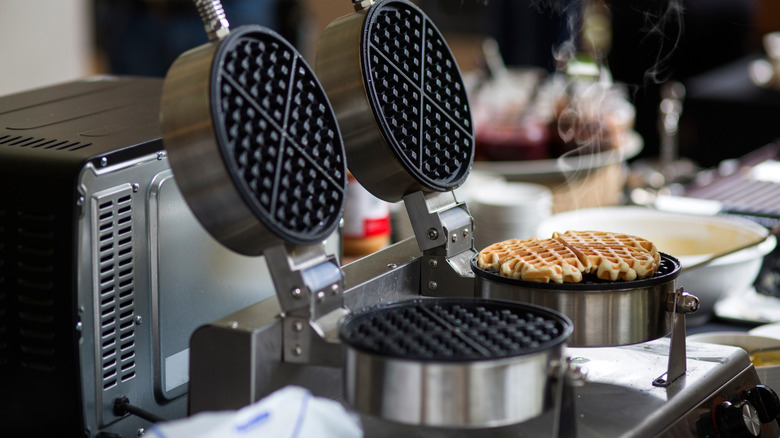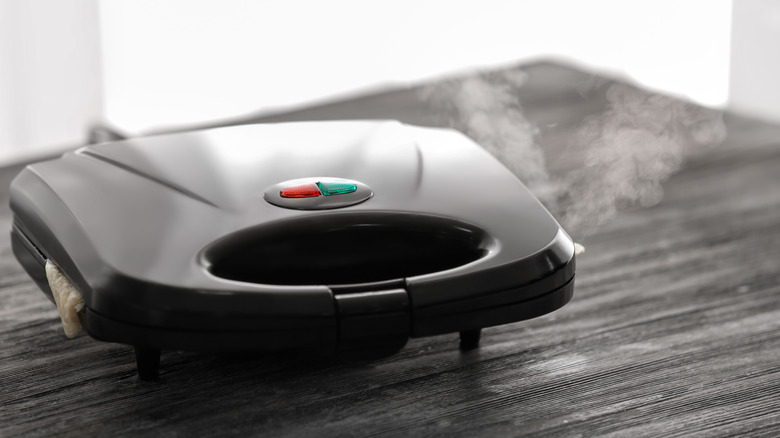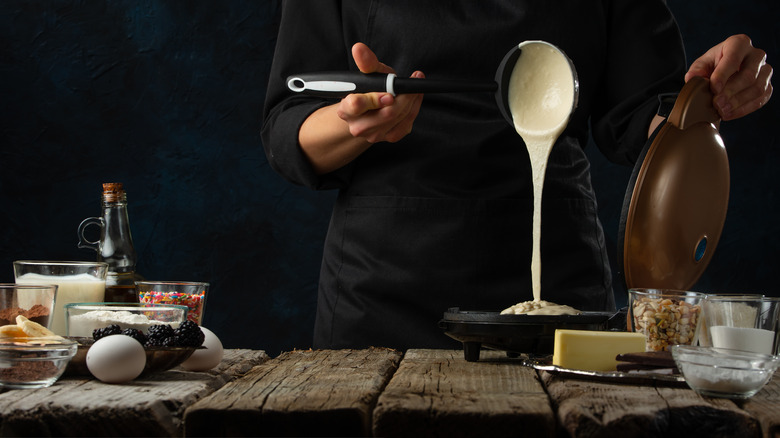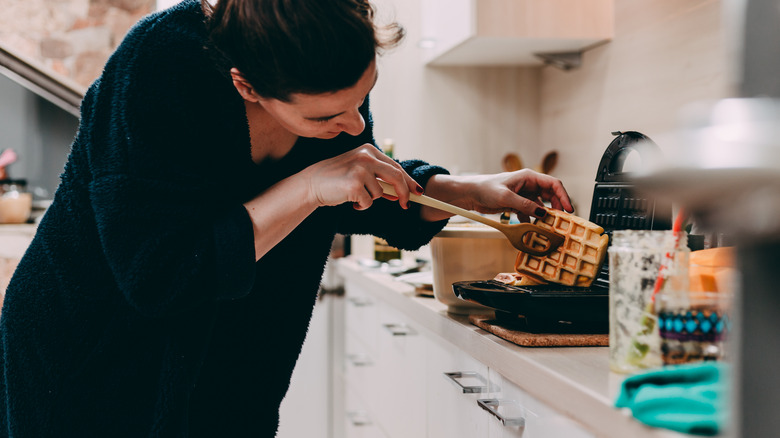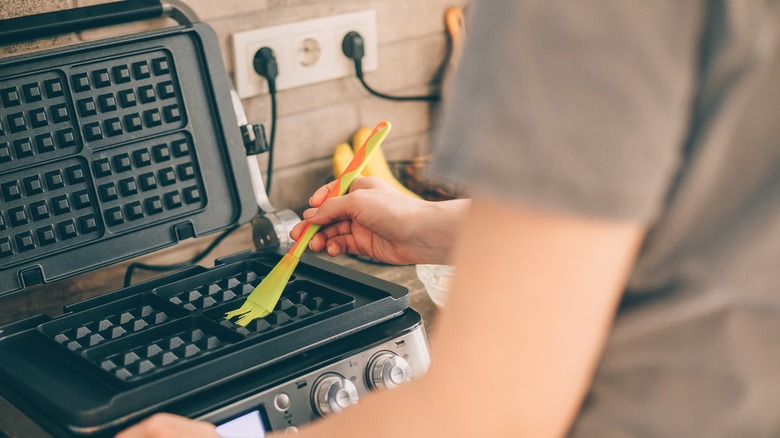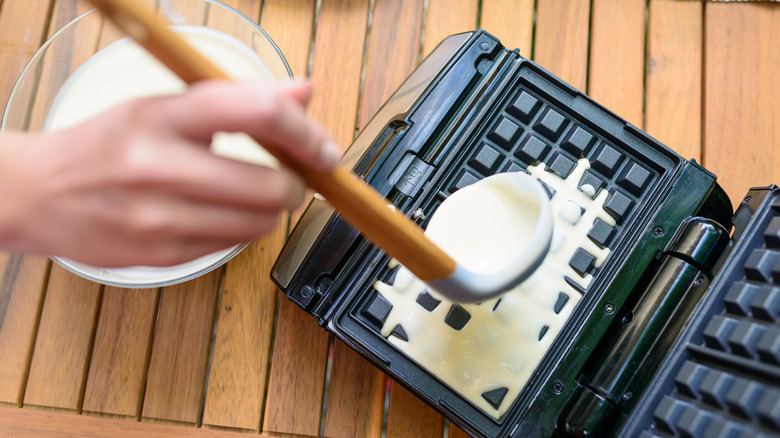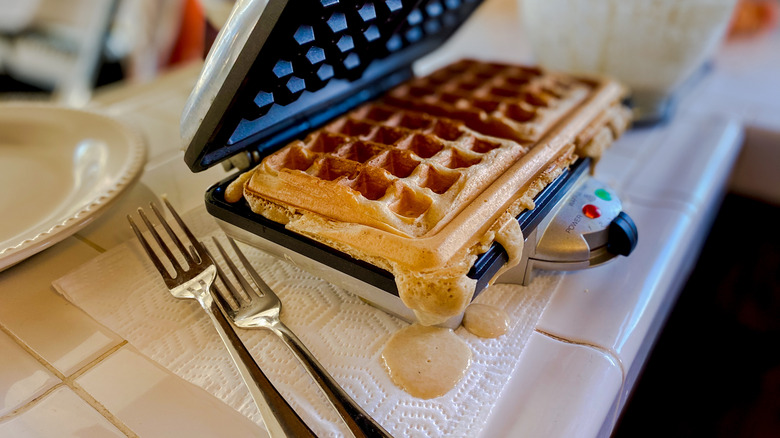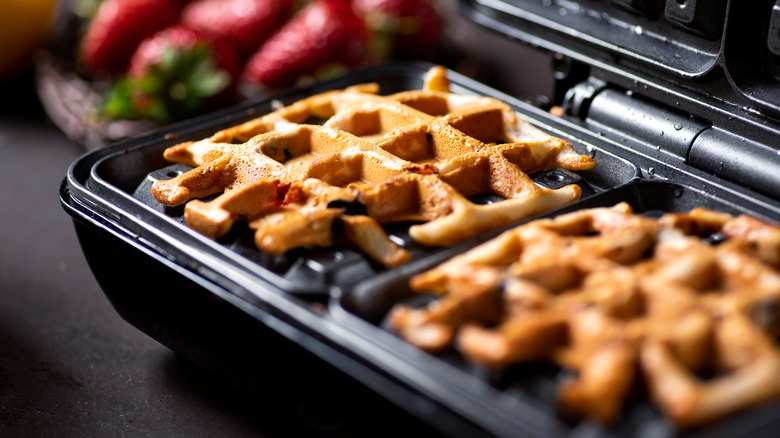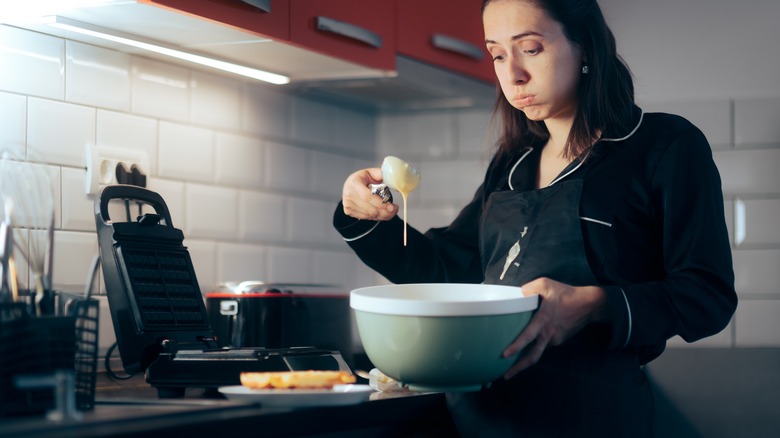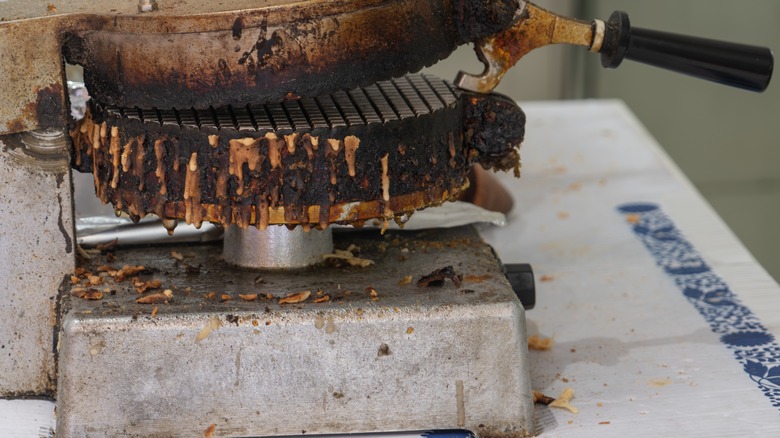Mistakes Everyone Makes When Cooking With A Waffle Iron
A weekend waffle breakfast is a wonderful way to start the day. The coffee pot is on, you're feeling relaxed after a lie-in, and you're happily hungry for a plateful of crispy and fluffy waffles. You mix up your batter for some traditional Belgian waffles and heat up your waffle iron. If you're feeling adventurous then you might want to add some secret ingredients that will make your waffles incredible. This may entail adding coffee, buttermilk, or cocoa powder to the batter. Or you could douse your waffles in maple syrup and serve them with bacon.
What could go wrong? Quite a lot, actually. Your batter could burn, your waffles could stick, and your waffle maker could overflow with hot batter overflowing onto the kitchen counter. But don't worry these are mistakes everyone makes when cooking with a waffle iron. To avoid waffle-making-induced stress, you just need to know how to avoid making these mistakes or become accustomed to solving them.
Only using it to make waffles
If you've got a waffle maker then it's a missed opportunity not to use it to its full potential. In other words, you don't just have to cook waffles in it. It's a great piece of kitchen equipment, and the hot irons are perfect for frazzling a surprising variety of dishes and snacks. There are so many different things you can make in a waffle iron. An omelet or a frittata is perhaps the simplest to make in a waffle iron. You can keep it plain or add fillings if you like.
You can also make a hash brown in your waffle maker for breakfast. Another great idea is giving dishes that you've already made a waffle-over by cooking them again in a waffle maker to add a crispy twist. Other examples of dishes you can make in a waffle iron include mac and cheese, leftover stuffing from a big meal such as Thanksgiving, and Korean rice with kimchi. You can also make Mexican quesadillas by putting flour tortillas on your waffle iron or add dough to make Italian pizza waffles. You can use a chickpea flour mix to create waffle-cooked Middle-Eastern falafels.
Not heating the iron enough
Waffles are so delicious because they're crunchy on the outside and soft on the inside. Regardless of the recipe you follow to make the waffle batter, it's essential to make sure your waffle iron is hot enough. If you add your batter before it has reached the right temperature then you're not going to achieve that crispy and fluffy contrast. You can follow your waffle maker instructions if there's a function that tells you when the irons are hot enough. Or you might want to use a thermometer.
If you make waffles frequently then it may be a case of trial and error in terms of timing how long to wait before pouring in the batter. According to ThermoWorks, the ideal temperature is 375 degrees Fahrenheit. A good tip is to make sure you let the irons heat up after cooking a waffle if you want to make another. The cooking process has a cooling effect, so it's important to pause between waffles if you're making a stack. Of course, you don't want them to go cold, so warm up your oven so that you can serve them while all lovely and hot.
Allowing in too much moisture
If you put batter onto a hot surface and cook it till the moisture burns off. That's why you'll notice a lot of steam escaping the waffles as they cook. It's important to let the moisture out; otherwise, the inside of your waffle might end up a bit wet or soggy. An easy way to make crispy waffles is to take them out of the waffle maker and pop them onto the oven on a wire tray rather than placing them directly onto a baking tray.
Preheat the oven to 200-250 degrees Fahrenheit and double-bake the waffles on a low setting for up to 10 minutes. This will dry out the waffle and give it a crispier texture. Heating your waffle maker to a high-enough temperature certainly helps in evaporation. Alongside this, a light batter can also help because it's less stodgy as it cooks. If you make buttermilk waffles then replace the buttermilk with regular milk. The batter will be runnier and less dense, which means that it won't become too soft, and it will stop the outside from hardening up. However, don't overdo it, as you want the inside of your waffles to have some fluffiness.
Not flipping the waffle
There are so many different types of waffle makers. There are the round ones that make one waffle at a time. The machines also have different settings depending on whether you're making a buttermilk, Belgian, or Liege waffle. And then there are the classic waffle makers that you can use to flip the waffles. There are modern electric versions, which you can flip. However, traditionally, this type of waffle iron was heated on a stovetop.
Either way, the benefit of flipping your waffle iron is that the batter reaches every part of the iron: This, in turn, creates an even bake. That means no more waffles nicely browned on one side and soggy and pale on the other. You also need less batter, and this results in a lighter waffle too. One mistake is to not flip your waffle if you're using the flipping kind of waffle iron. In fact, you flip twice. Once you've added the batter to the hot iron and closed the lid, you want to turn it over. You then leave it to cook before flipping it back when it's ready. This way, the batter gets to the higher iron immediately. In a non-flip style iron, the batter has to cook a bit before it hits the heat at the top.
Opening the waffle iron when it's still steaming
When you're hungry or just rushing around in the morning you don't want to be spending too much time making waffles for breakfast. However, if you're too impatient then you'll end up with a limp, undercooked batter that's not going to set you up for the day and may just give you indigestion instead. However, not all waffle makers have settings that let you know when your food is good to go. Even if you have to take a peek a couple of times, don't open it while steam is still streaming out.
The golden rule in waffle-making is that your waffle won't be ready until there's no steam. As soon as it stops, take a look and check that the color is a lovely golden brown and the surface isn't soft. There's no doubt that each time you check that you're also letting out heat which doesn't exactly help. Another reason not to do this is that you may ruin your waffle too. If part of it is cooked but the rest of it not then yanking open the lid might rip it.
Not adding enough oil or an egg
Liege waffles are heavier than your everyday U.S. variety. They're sweet, too, because the pearl sugar in the batter mix melts and creates a caramel flavor. In addition to being thicker and fluffier, these waffles also have stepped sides. Eggs are another ingredient in the batter. You can find batter recipes that don't add eggs into the mix. There are so many variations, and that's great.
However, not adding an egg or enough oil is a mistake. Our crispy waffle recipe doesn't include eggs in the list of ingredients. But it does have a good amount of coconut oil. To make five waffles using this batter, you're going to need two-thirds of a cup. If you don't have oil or an egg then your batter is going to stick to your waffle iron. It always pays to follow a recipe, even if you add your own tweaks over time. Another reason your batter might stick is not always because you're not adding enough oil, but it could be because you're adding too much.
Not cooking the waffles for long enough
The amount of time that you cook the waffles is not set. It depends on the thickness of your batter and the ingredients, as well as the type of waffle you're making. Our Norwegian waffles are made with yogurt and generally take around three minutes to cook. Apple pie waffles, with grated fruit in the batter, could take a little longer, with an estimated guide time of around four minutes. Another factor that affects cooking time is if your iron was super-hot when you ladled your batter. If so, then it's going to crisp up and cook quicker than if the heat is less intense.
A waffle that's not cooked properly will stick to the iron. If you've taken a look and it's not quite there, then add on another minute and check again. If you're making a few waffles then take note of how long the first one takes to give you a better idea. However, if you're making a big batch of waffles one after the other then they may need a bit of extra time as the iron heats up during the cooking. This technique could help you avoid waffles that stick and waffle-eaters who complain of underdone servings.
Using the wrong tools
If you've spent any time in the kitchen then you should know some basics about what utensils to use, how, and when. You should know it's dangerous to push metal cutlery into a toaster. And using metal anything when cooking with a non-stick pan is a no-no as you'll damage the surface. Even if you're a hardened waffle maker, using your hands to flip out these steaming batter grids is definitely a burn risk. to protect your fingers and your waffle iron you might find silicone utensils that can withstand some heat your best choice.
Carefully using tongs might seem like a good idea to prize out the crispy treats. But you want to be mindful of not pulling at the soft waffle with these as they might tear. If your waffle is a little stuck these may help if you're able to move it about a bit so it comes free. If you're the type of kitchen fanatic that like to have the right tools for the job then you might want to invest in a waffle pick. It looks like a tuning fork and is specially designed quickly and easily remove waffles once they're ready.
Making a batter that sticks
Many of the mistakes everyone makes when cooking with a waffle iron result in the batter sticking. That's why you need the iron to be hot, add oil or egg to your batter, and cook your waffles for long enough. Another common mistake is not getting the consistency of the mix right either. Too much liquid creates a watery batter. While you may have issues if your mixture is too thick, if it's too thin, then it will stick. If the surface of your waffle iron is scratched then these marks can create sticking points, so guard against this when taking the waffles out and cleaning the surfaces.
Sugar or any type of syrup or honey in the waffle mix adds to the chances of sticking. These ingredients make the batter sticky. While there are plenty of recipes that don't include any sugar, lots do. For example, making our gingerbread waffles requires adding add white granulated sugar and a couple of tablespoons of molasses. You might need to add some oil to the waffle maker for these sweeter recipes. Make sure you're not adding too much sugar, and be wary of adding honey.
Using cooking spray and not seasoning
You might think that giving your waffle iron a quick spritz with cooking spray avoids the waffles from sticking. However, after a while, this is going to create a tacky layer on the iron that actually sticks to the batter. You don't need a lot of grease, if any, on a non-stick surface. But you can wipe oil onto the surface before you plug it in. Oil on a hot iron is not a good idea. Use a paper towel then you're soaking up any excess and leaving behind a thin sheen. Canola oil is good to use because it has a neutral taste. Another method is to simply wipe melted butter or oil onto the iron with a silicone basting brush.
If you're using old-style, cast-iron versions, you have to keep the waffle maker seasoned. You will need to season the waffle maker in the same way that you might season a wok. One tip to do this comes from The Washington Post: Put a slice of buttered bread into the waffle maker and turn it on. Cook until the bread is brown, and then take it out before wiping over the surface. It's best to use unsalted butter. Or you could wipe the surfaces with oil and heat the iron for around 15 minutes and then let it cool down. In both cases, the iron is heating up so that grease covers the iron and stays in place.
Overfilling it with batter
Waffles are tasty, and they're also kind of neat-looking. They look and taste great as part of a meal, such as buttermilk fried chicken and waffles, or with fruit and cream as a dessert. If you're making a batch of waffles and are busy cooking other food, then the last thing you want to contend with is an overflow of batter. If the batter bubbles out the sides then it's going to be a real pain to clean up.
One reason this happens is that you're overfilling the waffle maker with batter. According to Big Time Kitchen, you only need around half a cup of batter for an 8-inch waffle. If it's half that size, such as the four-inch Mini Dash, then a one-third cup of batter will suffice. Another tip is to not fill the whole iron and add the batter to the middle only so that there's room for it to expand as it cooks. Another reason you might be getting an overflow is that the batter isn't thick enough, and so is running over the edge. If the temperature is too high this can result in rapid cooking, which can push the batter out. Not enough oil in a cast-iron waffle iron might allow this to happen too. If the mixture does slop out through the cracks, then turn off your machine before cleaning up.
Burning the waffles
While an undercooked waffle isn't worth eating, neither is one that's been cooked to the point of being incinerated. Burnt waffles not only taste bad, but they make everything else on your plate less than palatable as well. You might be thinking that burning waffles is an obvious mistake, but it's a common one. As the hot batter expands and freezes away as it's sandwiched between hot surfaces, it's no big surprise that waffles can go from soggy to burnt to a crisp in record time.
An obvious reason for burning any food is that you've left it cooking for too long. If your waffle maker doesn't have a timer on it and you're distracted, it's easy to let the time slip away. Setting a timer on your phone or a kitchen timer is a good idea. This isn't the only reason your waffles might turn out over-brown, though: It could be that they're simply cooking too quickly. Was the surface too hot when you added the batter? If the waffle iron is hotter than usual, then you may have to reduce the cooking time. Or maybe you want to reduce the temperature instead. Another reason that your waffles are burning is due to the sugar content in the batter. If the sugar content is high when compared to the other ingredients, then caramelization can cause the batter to burn.
Blaming the waffle iron for sub-par waffles
Have you ever heard the expression that it's a bad workman that blames his tools? It's tempting to point the finger at your kitchen gadgets when your culinary endeavors don't quite come to fruition. "It's not me, it's my waffle maker," you might cry as you serve up waffles that are either spongy or brittle. Or maybe they've stuck to the iron and are a torn-up mess, or the batter has seeped out. You might be right, of course, but it's worth looking at how your waffle-making skills might be lacking too. The batter, oil, temperature, and timings are all important factors.
However, even the efforts of the best chefs in the world can be adversely affected if the equipment isn't good. And there are some cases in which a waffle iron is to blame for sub-par waffles. The best way to find out if there's something wrong with the waffle maker is to check the surface for any damage. If you've tried out different adjustments to how you're cooking your waffles, but they're still sticking, then there might be a problem with your machine. If waffles aren't cooking evenly then this is also a sign that your machine isn't doing what it's supposed to. Check that it's heating up enough, and if it isn't then it might be time for an upgrade.
Cleaning the waffle iron when it is too cold
Have you been cleaning your waffle maker wrong this whole time? After a messy waffle-making session, you probably just want to sit down and, well, eat waffles, right? Hopefully, they're so good that you've polished them off before your waffle iron is totally cooled down. If there are any bits left on the surface, they could stick steadfast once cold, so clean your waffle maker while it's still warm. Don't try and clean it while it's hot or plugged in. If you use a soapy wet sponge on the outside, make sure it's wrung out when cleaning the inside for electrical items. On some models, you can remove the plates and wash and dry them separately.
If the batter is stuck on the waffle maker, add a little oil, leave for a few minutes, and then wipe off with a paper towel. Don't use anything abrasive with a non-stick surface. Fold a paper towel to wipe inside the grids and get to those less easy-to-reach areas. How Stuff Works suggests sandwiching some wet paper towels as if you're making a waffle. The machine should be off and cool. The remaining heat will release the moisture and steam-clean the surface. Don't forget to wipe down the outside before storing it away for your next wonderful waffle extravaganza.
